Top News
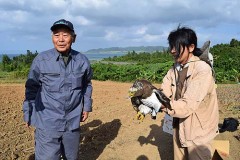
October 11, 2014 Ryukyu Shimpo
A Crested Serpent Eagle has recovered from injuries suffered in a road accident that occurred on Prefectural Road 79 in the Sakieda district of Ishigaki in September. It was released on October 4.
According to the Ishigaki Natural Conservation Office, the eagle is a young female bird previously in a car accident in December 2013 and taken care of by the office. Naming the bird Saki, the office attached her left leg with a green mark and the letter S, and released her.
Saki got hit by a car again on September 16. Masanobu Ishigaki, a farmer living nearby, found the bird lying still. The bird had no external injuries this time. However, she was concussed and unconscious.
According to the office, this year there have been seven car accidents involving Crested Serpent Eagles, in which three were found dead.
Ishigaki said, “I am glad that she had recovered. People should not drive fast. I would like to tell people living in the island and tourists to drive safely.”
(English translation by T&CT)
Go to Japanese

October 12, 2014 Ryukyu Shimpo
Cosmetic company Ecomap has developed a new facial soap using dolomite, which is an anhydrous carbonate mineral that includes calcium and magnesium. The mineral is produced in Kita Daito Island. This is the first time that a cosmetic item using dolomite has been developed in collaboration with Kita Daito Village. The company started selling the product from October 13. It plans to sell it at the Okinawa Industry Festival and Remote Islands Fair. The company also plans to put the soap on the international market.
The soap, created from dolomite, removes dirt and dead skin cells from pores. It includes an ingredient extracted from Daito shell ginger, which grows naturally on the island and hydrates the skin. The product won the Silver Award at the 2014 Monde Selection, an international food and alcoholic beverage fair.
At a press conference held in Naha on October 10, the CEO of the company Norifumi Miwa said, “We would like to buy the raw materials of the product from Kita Daito Village and benefit the village. We are aiming for 100 million yen on the settlement of accounts in March of the 2016 fiscal year.”
The soap is sold via phone and online at a price of 2,700 yen, including tax. For more details, please call the toll-free number on (0120)417.
(English translation by T&CT)
Go to Japanese
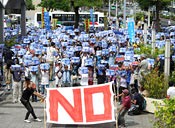
October 10, 2014 Ryukyu Shimpo
On October 9, citizen groups formed a human chain around the Okinawa Prefectural Government (OPG) buildings in Naha to demonstrated their united opposition to the construction of a new US Marine air base in Henoko, Nago, to replace the Futenma base in Ginowan. According to the organizers, about 3,800 people gathered and voiced their plans to stop the relocation of the Futenma base within Okinawa. The participants requested that the OPG reject an application submitted by the Okinawa Defense Bureau to change the method used for landfill, which is part of the planned base construction in Henoko.
This was the third rally opposing the base’s construction since July 1, when demolition of existing buildings started in Camp Schwab. Citizens, including parents and children, took part in the lunchtime rally. There were also some participants from abroad. Citizen group members, who continue to protest against the new base in Henoko and US military helipad construction underway in Takae, Higashi, joined in the rally.
The participants held blue signboards bearing messages, “No to a new base in Henoko” and “We will not surrender”. They chanted, “Stop the landfill for the sake of children,” and “Stop the new base and fight for the future.” They created a human “peace wave”.
Ashitomi Hiroshi, co-representative of the Helicopter Base Objection Association, said in his speech, “Our strike against the Henoko relocation will end in our victory. We will continue to fight at the scene. I would like everyone who lives in Naha, and central and southern parts of the island to fight together to win the victory.”
Rie Ishihara, a member of the group protesting against the construction of US helipad in Takae, stated in her speech, “The sea in Henoko and the forest of Yambaru are the treasures of Okinawa. Let’s protect the treasures of the islands and the future of children.”
Representatives of the four opposition parties of the Okinawa Prefectural Assembly made speeches.
(English translation by T&CT)
Go to Japanese
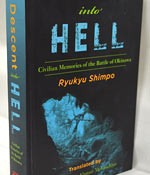
October 7, 2014 Ryukyu Shimpo
The Ryukyu Shimpo published a series of articles titled, Senka o Horu (Trans: Digging up the Ravages of War) between August 1983 and April 1985. An English translation of the article series has been published as a book in the United States, under a new title of Descent into Hell: Civilian Memories of the Battle of Okinawa. New Zealand researcher Mark Ealey and Alastair McLauchlan translated the articles for the book, published by Merwin Asia Publishing Co.
Ealey, who initiated the English translation of Senka o Horu, said, “I want readers who live in English-speaking countries and those who read in English to understand the misery of the war. Noncombatant people become the worst victims of war. The military was only concerned about itself. During the Battle of Okinawa, the Imperial Japanese Army sacrificed the Okinawan people in order to protect the main islands of Japan. Readers will have an opportunity to learn about the history of Okinawa.” He also wants young people with ties to Okinawa, who were born and raised abroad and cannot speak Japanese, to read this book.
Ealey is the translator of Rikugun nitohei Higa Shinichi (Typhoon of Steel, An Okinawan Schoolboy’s Quest for Martyrdom in the Battle of Okinawa) written by Japanese novelist Akira Yoshimura. The novelist depicts the Battle of Okinawa through the eyes of a student who is sent to the battlefield. Ealey came across Senka o Horu, published in the Ryukyu Shimpo, when he translated Junkoku into English. He offered to translate the articles into English and publish them in the United States.

Researcher and translator Mark Ealey
He has spent four years working to translate and publish the book. Looking back on the translation work, he said, “I felt more deeply the misery of the Battle of Okinawa, especially for the residents. I felt anger towards the Japanese Imperial Army, which treated the Okinawan people cruelly, including forcing mass suicide.” The title of the book Descent into Hell means that Okinawan people were trapped in hell.
His close friend and co-translator McLauchlan, Academic Program Leader at the Maori University, died without seeing this book. “I am so sad that I could not have published this book while he was alive,” Ealey said. He will visit Okinawa and tour the battle sites this month. He was initially scheduled to visit Okinawa with the co-translator.

Co-translator Alastair McLauchlan
(English translation by T&CT)
Go to Japanese
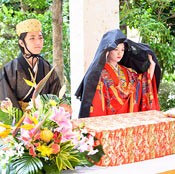
October, 8, 2014 Ryukyu Shimpo
On February 8, 2015, ANA Crowne Plaza Hotel Okinawa Harborview will for the first time sponsor a public Ryukyuan wedding.
At the public wedding, called “Ryu-kon in Kokusai Street & Tenbusu Naha,” a groom and bride will wear traditional Ryukyuan clothes and walk with their families from the Mutsumibashi intersection to the Naha Bunka Tenbusu Hall. The couple will perform a newlywed ceremony of Nudinuchaaji, in which the couple wears a piece of kimono, and a ceremony of Ubinadii, when water from Izumizaki is used for cleansing. After the wedding ceremony, the bride and groom will dance kachashii with their families and tourists around them.
The hotel will cover the cost of the wedding ceremony, outfits, and accessories. Applicants must be a couple over 20 years old that has not held a wedding ceremony. The hotel will call for applications from couples that want to hold a public wedding, until October 31, and it will contact one elected couple on November 2. For more information, call ANA Crowne Plaza Hotel Okinawa Harborview Wedding Salon at 098 (853) 2117.
(English translation by T&CT and Megumi Chibana)
Go to Japanese
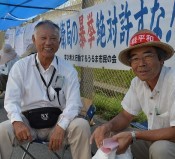
October 8, 2014 Ryukyu Shimpo
In front of the gate at Camp Schwab in Nago, about 40 citizens continue to stage a sit-in-protest against the construction of an alternative base for U.S. Marine Corps Futenma Air Station, which the Japanese and US governments want to relocate to Oura Bay, off the coast of Henoko. On October 8, 20 members of a Hokkaido-based volunteer group dedicated to the recovery of remains of those who died while working in coal mines during the Pacific War, took part in the sit-in for the first time. A representative of the group Makoto Tonohira said, “By taking part in the protest, we were able to learn that the Japanese government lied to us. The thoughts of the sit-in protesters tell us the truth.”
On October 10, approaching typhoon Vongfong made the seas rough in Henoko. Subsequently, there were no Okinawa Defense Bureau or Japan Coast Guard ships.
(English translation by T&CT)
Go to Japanese
October 8, 2014 Ryukyu Shimpo
An inquiry has revealed that from July 2011 to August 2014, 23 servicemen deserted from U.S.military bases in Japan nationwide. Among them, four deserted from the bases in Okinawa. One of the four deserters from the bases in Okinawa gave themselves up to the military and two were arrested, while one is still at large. Kantoku Teruya, a member of the House of Representatives, received an answer from the National Police Agency to his inquiry regarding deserters on October 7.
Since the 2008 fiscal year, 19 soldiers deserted from bases in Okinawa. Three of them remain at large. Two marines and one army soldier have still not yet been located. At the Japan-U.S. Joint Committee in May 2008, the governments of Japan and the United States reached an agreement on deserters from the U.S. bases in Japan. If soldiers desert, U.S. military officials will immediately ask the Japanese police to secure their arrest, and to report the situation to local governments.
Although a marine deserted from one of the bases in Okinawa in March 2013, the U.S.military notified and asked the Okinawa Prefectural Police to arrest the solder about three months after the desertion. The U.S. military failed to comply with the agreement.
Following a taxi driver murder-robbery committed by a U.S. soldier in Yokosuka, Kanagawa Prefecture in March 2008, the governments of Japan and the United States have agreed to notify each other regarding deserters from U.S. bases. Based on a special criminal law clause in the U.S-Japan Status of Forces Agreement, Japanese authorities are required to hand over deserters to the United States if the Japanese investigative organizations apprehend the soldiers.
(English translation by T&CT)
Go to Japanese
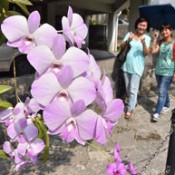
September 30, 2014 Ryukyu Shimpo
Orchids growing on the trunks of trees called Kuroki or Unbarked Lumber are attracting pedestrians on Kinjo Dam Street in Naha. Members of the Kinjo Dam Street Group planted the seedlings of orchids around the trees. Currently, five or six orchids such as den-phal, cooktown, moth and cattleya have grown up the sides of both trees. Purple cooktown orchids are blooming just across the street from an animal clinic owned by Tetsu Nonaka, a former head of the Kinjo Dam Street Group. He said, “Some people pick the orchids, and I get so frustrated. But I enjoy planting orchids. I would like to increase the amount of flowers here.”
(English translation by T&CT, Hitomi Shinzato)
Go to Japanese
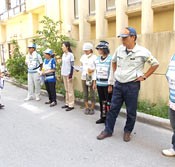
October 6, 2014 Yoshikazu Miyazato, correspondent of Ryukyu Shimpo
On October 1, The Zamami Village Office started enforcing a regulation to clean and beautify the Kerama islands. The regulation aims at creating a clean and comfortable environment deserving of national park status. Locals and tourists are required to do their bit to beautify the islands, such as carrying out waste separation. The beaches around the islands are now entirely smoke-free. Twenty supervisors selected from among the villagers are patrolling harbors and districts.
Kerama Islands has been designated as a national park. The village assembly enacted the regulation at its March regular meeting, responding to a request from residents. The regulation started on October 1 after a “get-acquainted” period of six months.
In the morning, the supervisors patrolled Aka and Geruma Island and advised the residents on the new regulations. They also visited Zamami Island in the afternoon. They found junk cars and boats left on the islands and notified the municipal office to have them removed. They will request that owners of vending machines in front of supermarkets or shops ensure that trash bins are installed and in a tidy manner.
(English translation by T&CT)
Go to Japanese
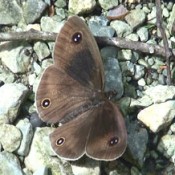
September 30, 2014 Ryukyu Shimpo
Akino Miyagi, a committee member of the Nature Conservation Committee of the Lepidopterological Society of Japan, captured on camera three near-threatened species of rare butterflies, on September 25 in Higashi Village, Takae. Takae is near the designated construction area N1, where a helipad is to be relocated as part of the agreement returning a portion of the American military’s Northern Region training area. Miyagi said, “It is unusual to be able to take photos of all three species on the same day,” emphasizing the richness of nature in the area.
The three species seen near N1 are Ypthima riukiuana, Pithecops corvus ryukyuensis, and Artipe eryx okinawana.

Pithecops corvus ryukyuensis
Miyagi confirmed that about 30 individuals of Ypthima riukiuana inhabited the area near N1. This is the first time Ypthima riukiuana has been confirmed near N1.
Almost 30 individuals of larval and cocoonal Pithecops corvus ryukyuensis were found near the forest around Arakawa river, which flows in the Takae area.
Two helipads have already been constructed in the N4 area around Takae and are likely to be used for training by the the American military. There are also plans for construction of two new helipads at N1. Logging, excavating, and mounding will be carried out during the construction.
“Takae is a treasure trove of rare butterflies. This might be affected if the forest is destroyed due to construction work,” Miyagi said, expressing concern.

Artipe eryx okinawana
(English translation by T&CT and Lima Tokumori)
Go to Japanese
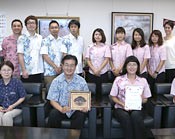
October 6, 2014 Ryukyu Shimpo
Meio University’s team won the top prize in the international division of an essay contest at the GPAC2014 (Global Partnership of Asian Colleges), held at Vietnam National University in Hanoi from August 24 to 29. Eleven students from Meio University took part in the conference. On Sept. 25, the students reported their achievement to the university’s president Katsunori Yamazato.
GPAC is an annual international conference in which university students from countries in Asia deepen ties by presenting academic papers on a common theme, such as the environment and the economy. About 150 students from six countries, including Vietnam, Taiwan, South Korea, China, Israel and Japan, took part this year. The top prize-winner’s team members include Karin Yamagishi, Kei Ikeda and Yuki Gima. They presented an essay in English titled “Okinawa as the Center of East Asian Logistics: A Case Study of Air Freight Operations by All Nippon Airways at Naha Airport”. Their essay received high accolades.
Team leader Yamagishi said, “We were very nervous to do a presentation in English for 10 minutes. But, it was a happy occasion for us because we were able to convey the charm of Okinawa to the world.” Gima said, “We had received a lesson on presentation, including eye contact communication. We were able to improve our presentation skills during summer vacation.”
Yamazato, the president of the university, praised the students, saying, “The teamwork of the students and very fine teaching from staff members bore fruit. This award will also encourage other students.”
(English translation by T&CT)
Go to Japanese














 Webcam(Kokusai Street)
Webcam(Kokusai Street)


